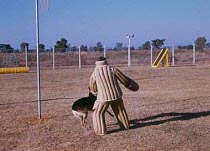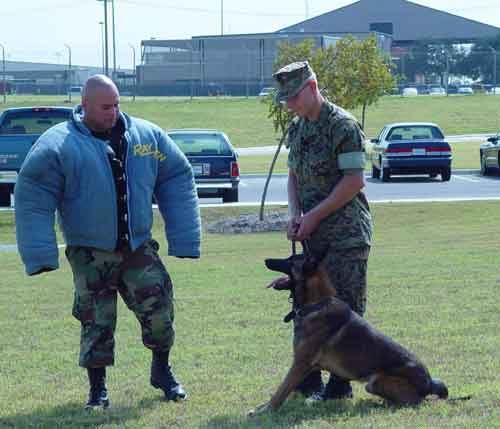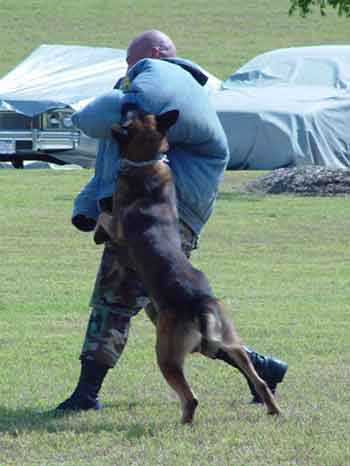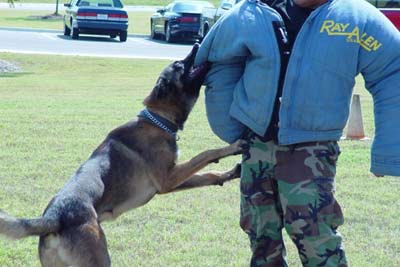What is the difference between patrol and sentry dogs? The easy way is to explain the use of force rules. When a sentry dog was released the situation had evolved to the point that deadly force was also authorized. You could shoot firearms, throw grenades, explode claymore land mines, call in air support, call in artillery, or release the sentry dog to attack (if you really wanted to hurt him). A patrol dog is considered minimal force. If the situation has evolved to the point that you have to physically grab the suspect to subdue him, the dog can be used. Toward the end of my AF career I was a law enforcement flight chief. I always had a dog handler respond and stand nearby at disturbance type situations. I would tell the suspect that he would cooperate or I would reach out and touch him on the shoulder. If he resisted, he could wrestle with the dog. Strangely enough, I never had anyone decide to roll in the dirt with Rover. Stand-Off was the training that cause patrol dog to be considered minimum force. If a suspect stopped fleeing after the dog was releases the attack could be stopped. I have seen dogs commanded to stop actually turn their head away from the decoy. They were traveling so fast or already in mid air band and knew they would hit the "bad guy". Some dogs would slow but continue to the decoy, then nearby turn back to the handler. In the 70's the majority of the students were active duty Air Force. The majority if the instructors were AF personnel. There were no US Navy Instructors, no US Marine Instructors, and only a few Army instructors. Now, the instructor staff is made up from all of the services. Does this create a difference in the quality of the training ? Probably not, only the Army had a specific MOS (career field) for dog trainer. That’s a move the AF should have considered years ago. I hope the Army still has that MOS. The majority of AF instructors were eventually promoted out of the job that they loved. Also the number of dog teams used by the Air Force has dropped to less than 25 % of the 1970's manpower level. Sentry dog leash attack training was accomplished with the decoy wearing a thickly padded suit that covered everything but the face. This unwieldy suit was very hot and uncomfortable. The suit covered everything but the decoy's feet and the top of the head. Photo below: Sentry Dog Suit used at a SEA base during the Vietnam war.
In a few cases, sentry dogs were released on intruders that should have been bitten, but the dog did not. By equipment association, they had realized that the "Bad Guy" was always dressed in the attack suit. If he was not in the suit, the dog did not know what to do. A special attack muzzle was developed. This covered the dog's muzzle more complete than the usual basket muzzle. During the muzzle attack the dog was released off leash on a decoy that did not have any protective gear. Some dogs would stop and try to pull of the muzzle with their front paws. It was a leap of faith that the handler had properly tighten the muzzle. The aggressive dog would hit the decoy and then attempt to rub the muzzle off . The patrol dog concept was a spin off from the police dogs used by the Metropolitan Police Department , Washington, DC. The dogs were taught to attack, release the bite on command, and stop the attack if ordered prior to the physical bite. The dogs would still scout using the senses of smell. hearing, or sight. In the early 70's, the AF had no supply system setup for ordering attack gear. The patrol dog was attack trained using a very small protective sleeve. Patrol dog instructors scrounged the necessary items. The vet clinic provided elastic bandages. The fire department provided old fire hoses ( a short section provided a open sleeve of canvas & rubber. The kennel support a light canvas used as target cloth and the sun screen of the old temporary kennels. The cloth wrapped around the arm a few turns gave something for the pup to sink it's teeth into. Wraps could be worn under a field jacket and provided minimum protection. Air Force bases that had aircraft had parachute shops that had the equipment to sew heavy material. At Clark AB, RP the shop sewed layers of leather on a sleeve and made nylon leashes for us. This sleeve offered minimum protection. The dog's job was to bite the decoy. The decoy's job was to ensure that only his protected arm ended up in the dog's mouth. In the early days, many patrol dog students were treated for dog bites. Few sentry dog students were bit while conducting attack training. Usually if a sentry dog handler was bitten, it was usually by his own dog. Some dogs did not respond well to being told that they had to stop attacking. It was common for a Sentry dog handler to actually choke their dogs to get them to release a bite. Some dogs would attack the handler for attempting to stop them from biting the intruder. As years went by, the size and bulk of the wrap has increased. We would sometimes throw a bare sleeve in front of a dog during a off leash bite. Many dogs would stop to bite the sleeve or wrap and ignore the decoy. Once again a protective suit is being used. You decide if the dog's can tell when the person is in the attack suit. Long after I retired I saw a demo where the "bad guy" was wearing a black leather suit. I thought they were training the dog to attack SCUBA divers. Photos Below: New attack gear for "modern" patrol dogs. The size and appearance of this jacket could cause the same conditioning problems that sentry dogs experienced in the late 60's. In essence, they are being trained only to attack someone who appears this way. In the early days wraps were much smaller. I have seen a disturbing trend for civilian police officers to feel that a rope pull toy is used as a reward after a bite. This makes no sense to me, the bite is the reward if the dog is truly aggressive. Also this is a muscle memory builder that the handler does not want to develop as an automatic action. In a real world scenario, don't start searching pockets for a toy.
|





